Adapt Your Wheels to Fit Bigger Tires
When They Wanted Bigger Tires for Better Autocross Control, They Turned to Strong Spacers and Fender Rolling. It’s an Approach That Works for Street Vehicles As Well.
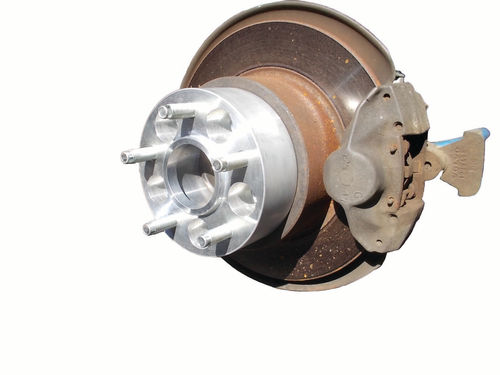
BUSTER IS A 1986 Volvo 245 wagon that you met in the November 2014 issue of Auto Restorer. Driven by our family his whole life and now belonging to my daughter, Amanda, these days he is used almost exclusively for our father/ daughter autocross racing. While he has never undergone a complete restoration, he has had lots of body and rust repair over the years. His engine is fine with 275,000 miles, he still has a nice interior and his 134a A/C works great. He is licensed for the road and carries all our autocross equipment to all the events. We also try to keep improving his performance in autocross events without spending a fortune. In May 2015, you saw him receiving a new windshield after two decades of pitting made it difficult for us to see when the sun hit the glass.
Our Tire Usage Evolves
Autocross performance means lower run times through a winding course. Light, powerful cars have a big advantage over a heavy (2900 lbs.), underpowered (114 hp) car like a Volvo 245 wagon. So in 1998 we made our first upgrade to Buster's cornering ability. We bought four used race tires for his 15x6 Volvo “Virgo” forged aluminum wheels. Buster came to us originally with Volvo steel wheels that were 14x5.5, but the Virgo wheels were an option that appealed to us and we bought a couple of used sets many years ago.
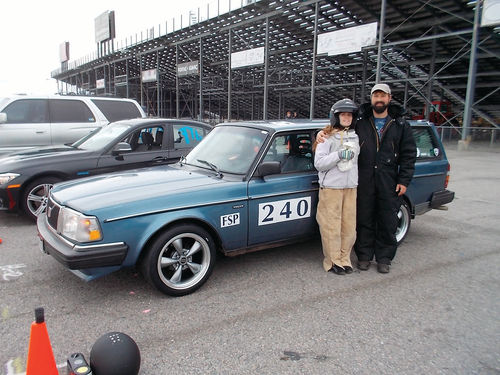
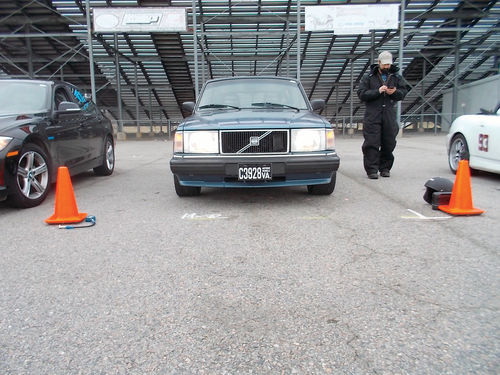
As a result of this change, his tires went from 185/70/14 to 205/50/15. These soft-compound race tires made a huge difference in handling grip and fit the chassis without any modification. This improvement was trumped by the discovery that 225/50/15 tires also fit. That is, they cleared the chassis and bodywork. But they did not sit so well on the 6-inch-wide wheels. Still, it was a big improvement once more.
The next upgrade to the car was an assortment of suspension components from Volvo specialists IPD in Portland, Oregon. We traded the stock springs for shorter, stiffer springs and changed out the anti-roll bars for a larger size. We also fitted an Eaton Truetrac limited slip differential to the Volvo’s Dana 30 rear axle. We moved the battery from the left front corner to the right rear corner, and replaced the mechanical fan with an electric fan from Advance Auto Parts with a cutout switch to prevent the 16- amp load on the alternator during a run. We added a cold air intake (homemade) and a high flow K&N air filter from IPD.
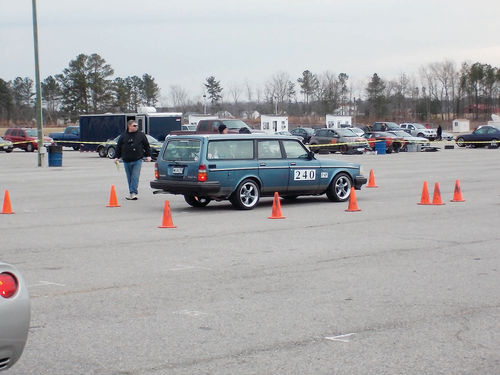
Reclassification Leads to More Modification
These changes pushed us into a different class with a new higher handicapping factor. At the same time, the SCCA changed the rules for “street classes” by upclassing everyone who ran soft-compound race tires. This change was overdue in my opinion, and benefitted all the drivers who ran on their street tires. Race tires are expensive and often don’t last even one season. The whole idea with autocross is that everyone can participate.
For those of you who follow autocross, we moved from H Street (HS) to F Street Prepared (FSP) class. The handicapping (PAX) factor went from .796 to .840. Ouch. So our raw times for each run are multiplied by .840. A stock Corvette on street tires would be .835 PAX.
Of special importance, our new class allows the use of any size wheel and tire and also allows wheel spacers, a change which we’ll be discussing in this article.
In this discussion I will be using the chart seen on these pages. My data source was Tirerack.com, where each tire has a “specs” tab that you can click on which shows the specifications. In this case, I used the BF Goodrich g-Force R1. This is a tire designed specifically for autocross and road racing. They are not suitable for normal street driving because of the cost, the rapid wear, and the lack of treads. Hopefully this article can help with street tires as well, as they are spec’d in the same manner as race tires.
Let’s Go for Bigger Wheels & Tires
In spite of the larger race tires, we were still not satisfied with our cornering ability. Racing aside, many car enthusiasts would like to fit larger tires on their classics, especially if their classic is a driver or a resto-mod and not an original show car. So our experience may be helpful to others seeking larger or more up-to-date tires for their daily drivers. As noted above, our new class did not limit the size of wheel or tire, so we began looking into larger tires and wheels. However, we quickly realized that we could not find reasonably-priced larger wheels that fit a Volvo 240 bolt pattern. We were willing to stuff a really wide wheel into the Volvo fenders, even if that meant trimming the fender lips off. In fact, it was Amanda who said “If we are going to do this, we need to do it once and fit the absolute largest tire we can.”
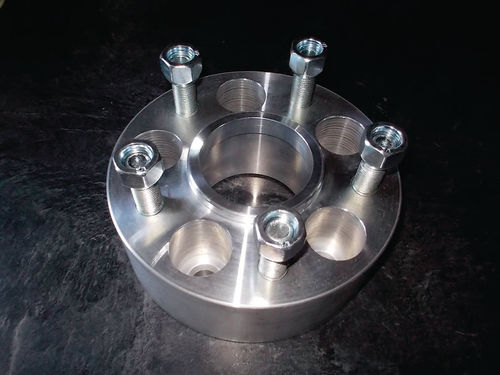
We already had a set of four aftermarket aluminum wheels in 17x9 from American Muscle, made for a 2005-2009 Mustang GT. They were used but very sharp-looking and are called “Bullitt” wheels reminiscent of the Steve McQueen movie. So we set about calculating if and how these might work on the Volvo, with bigger tires. This is where things became complicated…

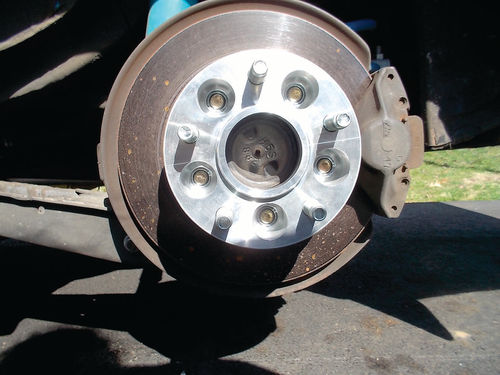
We Found Differences Between Our Volvo and Mustang Wheels
1. The lug bolt pattern is different. Volvo uses a unique bolt pattern and has done so since the 1960s.
2. The offset from the hub face was different. Volvo Virgo is 4.31 in. and the Bullitt is 6.81 in.
3. The width was different, 9 inches instead of 6 inches.
4. The diameter was different, 17 inches instead of 15 inches.
5. The diameter of the machined center hub hole was different. This is the feature of the wheel that precisely centers it on the hubs on the car. The Volvo used a larger bore.
The only thing that was the same was the number and size of the lug studs on the Volvo and a Mustang. Both are ½ inch, SAE thread and five in number.

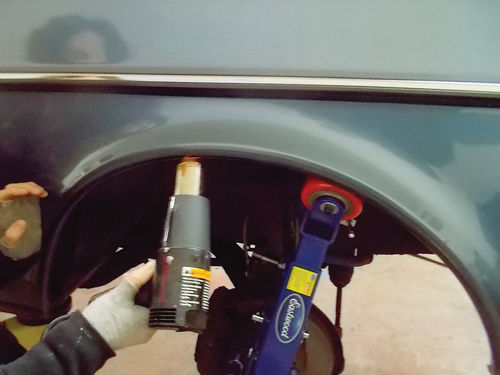
There Were Limitations Imposed By the Car
There also are places where the tires could interfere with the body and suspension parts of the Volvo.
1. In the front, the lower spring pad on the struts limits the overall diameter to about 25 inches.
2. The strut tube itself limits the total width of the tire measured from the face of the hub to the strut to about 5.25 inches. The rear upper shock mount also imposes this same limitation.
3. The wheel arch lip limits the total distance from the face of the hub to the inner fender lip to about 4.75 inches. So we were looking for a 10-inch- wide tire.
I used the word “about” here. That’s because none of these measurements are from one flat surface to another. So as I went along in the calculations, I tried to err on the smaller side because it is not easy to exchange tires once they have been test mounted.
I used the assortment of mounted tires and wheels that I already had to check clearances. I could mount them on the car and check the clearances with weight on the suspension. Another way to do this is to buy or borrow used tires. Oftentimes tire dealers will let you go through their tires designated to be recycled.
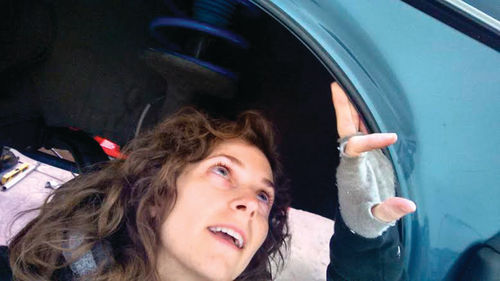
What made it possible to use the 17x9 Mustang wheels is that they have a much deeper offset measured from the inside lip of the wheel to the mating surface for the hub. This gave us room to accommodate wheel spacers that also converted from a Volvo to Ford bolt pattern.
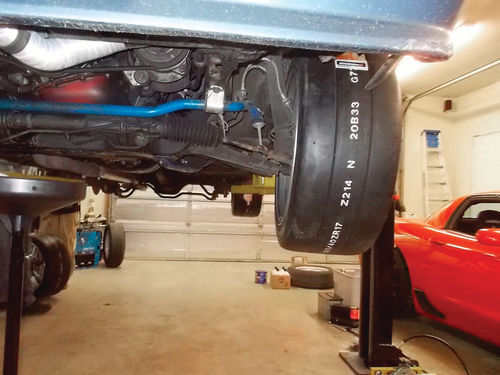
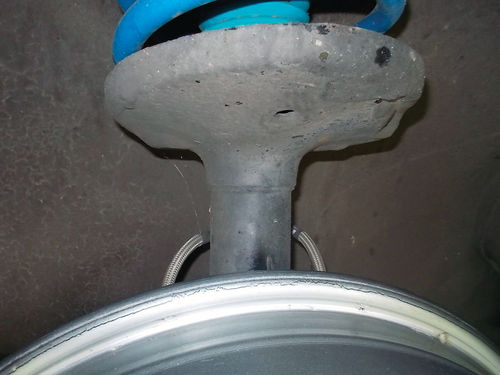
So the Guidelines Were…
1. To provide the new tires with section dimensions that left the inner surface the same distance in from the hub face as the stock tires, coming close to, but not rubbing on the front strut tube and the rear shock mount.
2. To provide a section width (about 10 inches) that would fit between the same inside position and still clear the fender lips.
3. Remain within the 25-inch- overall diameter.
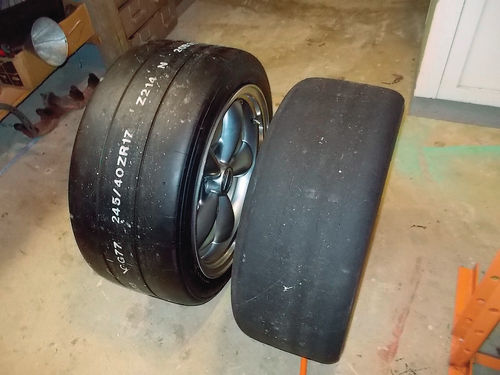
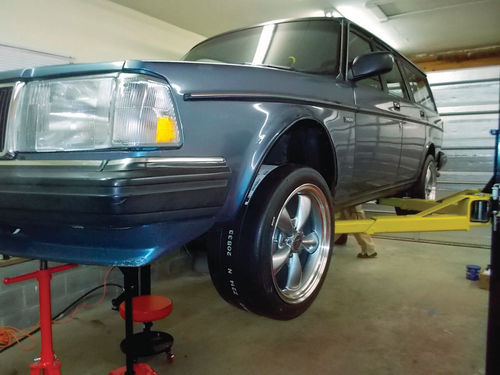
Finding Suitable Wheel Adapters
Using the Mustang wheels meant calculating the spacer thickness that would set the wider wheels the correct distance from the hubs so that a 10-inch-wide tire would have its inside sidewall bulge in the same place as the stock tires. By measuring the offset of each wheel, the 15x6 Volvo Virgo and the 17x9 American Muscle Bullitt, then adding in the sidewall bulge by consulting the tire specs on Tirerack. com, the spacers required calculated out to 1.88 in. In order to err on the side of more clearance, rather than less, we settled on 2-inch spacers.
Because of the stresses the spacers would be subjected to in autocross, we went with a top-quality manufacturer, US Wheel Adapters of Aurora, Colorado. It is important, when fitting wheels to cars, that the machined bore hole in the center of the wheel fits snugly on the raised machined cylinder in the center of the hub. US Wheel Adapters took care of this as well as the difference in lug bolt patterns. The spacers were machined to fit the Volvo hubs on the inside, and the Ford wheels on the outside. The spacers are plenty thick so that the Volvo lug studs and standard lug nuts are completely swallowed by the spacers. So there are 10 lug holes in each spacer, all precision drilled and machined. Five new studs were pressed into the spacer’s Ford holes. These spacers were custom-made, but the cost was reasonable and the workmanship and delivery were perfect. US Wheel Adapters know their craft and clearly take pride in their product.
Again, to err on the side of more clearance, we bought a set of 245/40/17 tires for the American Muscle wheels. We had Tirerack ship the tires directly to Amanda’s house, where there is a tire machine. When I installed these on the car, it appeared that a good deal of fender rolling was required. I should have waited for Amanda to look at what we had, but I was (over) anxious to get started. So I grabbed up the Eastwood fender roller. (Editor’s note: For more on working with the Eastwood fender roller, see the May 2014 issue.) Now there was a lot of guestimation on my part, because the tires didn’t rub anywhere just sitting still. The suspension movement comes into play, so I tried bouncing the car but it won’t bounce much because of the stiff springs and shocks. But instead of waiting for Amanda to help me, I went to work on the left front fender first. Before I knew it, I had bent the heck out of the fender. I just rolled it to ruin. If we ever get Buster painted, we will have to replace the fender. So I stopped. I wish I had a nickel for every mistake caused by impatience... You know the rest. Later, at Amanda’s garage, we put Buster on her lift and she gently rolled the fender lips on the other three corners. We went out for a “slalom” drive and tried to get the fenders to rub. They didn’t.
We Can Even Grow Some More
After a whole season of racing with this setup, it has become clear that we did err on the side of extra clearance. The fact is we could have gone to a 255/40/17 tire. There is plenty of clearance on the inside sidewall and they still come in under 25 inches in diameter. They would sit on the wheels better. We will get those tires next, but the 245/40/17 donuts we have did not wear out in one season so we can still run them for a while. Buster’s handling has improved again and the cornering is balanced and predictable even in the wet. More grip means less wear.
So you can see there is some simple arithmetic and some guestimation, and a little luck, but you might be surprised at how much different your ride can look with bigger tires. Many enthusiasts like to see a full wheelhouse, even if they don’t autocross. The nearly infinite array of wheels, available today, is boggling.
















